Cyclone Owen
Severe Tropical Cyclone Owen was a long-lived and erratic tropical cyclone that hit Australia in mid-December 2018. Owen was also one of the earliest tropical cyclone in a season ever to form in the Coral Sea. Owen was the fourth tropical low, first tropical cyclone, and first severe tropical cyclone of the 2018–19 Australian region cyclone season. Owen formed on November 29 from an area of low pressure situated over the Solomon Islands, which itself formed on November 27. As a tropical low, Owen produced some minor impacts in Papua New Guinea and the Solomon Islands. Owen slowly strengthened, but then degenerated into a remnant low on December 9, just after entering the Gulf of Carpentaria. It was dubbed "the zombie cyclone" after regenerating on 12 December. Cyclone Owen rapidly intensified into a Category 3, and circled around the Gulf of Carpentaria.
| Category 3 severe tropical cyclone (Aus scale) | |
|---|---|
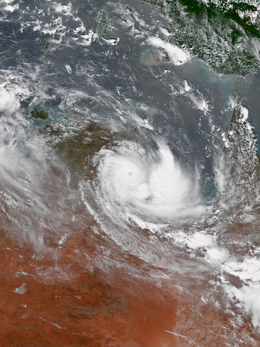 Owen on 13 December at peak intensity | |
| Formed | 29 November 2018 |
| Dissipated | 19 December 2018 |
| (Extratropical after 17 December) | |
| Highest winds | 10-minute sustained: 155 km/h (100 mph) |
| Lowest pressure | 958 hPa (mbar); 28.29 inHg |
| Fatalities | 1 |
| Damage | $25 million |
| Areas affected | Solomon Islands, Papua New Guinea, Queensland, Northern Territory |
| Part of the 2018–19 Australian region cyclone season | |
Then, it struck Queensland, killing one person and causing over $25 million dollars worth of damage. After re-entering the Coral Sea, Owen quickly weakened, and eventually dissipated on December 17. The remnants of Owen continued to persist for a couple of days, before dissipating entirely on 19 December.
Owen was actually beneficial to some parts of Australia during its duration. The rainfall that was dropped on deserts helped farms and put out a bushfire. The final advisory was issued on December 17, when Owen was situated between Townsville and Cairns. However, Cyclone Owen's extratropical remnants persisted until December 19. The erratic path of Owen is thought to come from a high-pressure area that tracked near the storm. Owen also had the highest rainfall ever recorded in the month of December. Over 157 millimetres (6.2 in) of rain fell in Australia alone.
Meteorological history
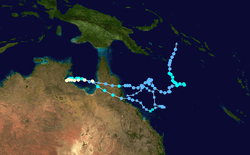
During 29 November, the Australian Bureau of Meteorology (BoM) reported that Tropical Low 04U had developed about 500 km (310 mi) to the northwest of Honiara in the Solomon Islands.[1] Over the next couple of days, the system moved southwards over the Solomon Sea and gradually developed further, with atmospheric convection consolidating close to the centre.[2] The moderately favourable conditions caused Tropical Low 04U to further develop and gain some convection.[3] These conditions contributed to 04U's convection, and at about 12:00 UTC on 2 December, 04U strengthened and was named Owen.[4] However, Owen soon encountered relatively unfavourable conditions, and struggled to maintain deep convection.[5] The increasing wind shear and other factors caused Owen to weaken slightly early on 3 December.[6] Soon after that, though, Owen gained a burst of convection, and strengthened again.[7] By noon on 3 December, Owen was struggling to remain a tropical cyclone and could not intensify further.[8] As the day progressed, Owen became increasingly disorganized, and continued to weaken.[9]
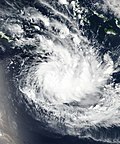
By 4 December, Owen was continuing to lose convection and diminish. However, in the east, convection remained, so Owen moved slightly to the east.[10] However, to the east, Owen encountered even more unfavorable conditions, and weakened into a tropical low.[11] Over the next six days, Owen moved towards Queensland as a tropical low.[12] Then on 10 December, Tropical Low Owen made landfall in Port Douglas. Owen caused severe damage there. Then, late on 10 December, Owen entered the Gulf of Carpentaria.[12] Conditions in the Gulf of Carpentaria were more favourable than in the Coral Sea, which caused 04U to become more well-structured and strengthen slightly.[13] 04U continued to move westward through the Gulf of Carpentaria, and convection increased through early 11 December.[14] Then, at about 12:00 UTC on 11 December, 04U weakened a little, since conditions were becoming unfavourable.[15] Over the next few hours, 04U's intensity remained largely unchanged; as conditions were not unfavourable enough to make it dissipate, but they were not favourable enough for 04U to strengthen.[16] By 12 December, 04U was still slowly moving west and not changing intensity.[17] Early on 12 December, though, conditions started to become favourable, and 04U's convection increased.[18] Then, at about 12:00 UTC on 12 December, 04U strengthened into a Category 1 tropical cyclone. Cyclone Owen was given the nickname "zombie cyclone" as a result.[19]
Owen rapidly intensified overnight into a low-end Category 3 severe tropical cyclone, making its outer bands hit areas of Queensland and Northern Territory.[20]
The newly named Cyclone Owen moved southward, away from the Solomon Islands,[21] then veered off to the east on 3 December.[22] Going west, on 4 December Owen weakened into a tropical low, briefly turned extratropical before becoming fully tropical again,[23] and traveled towards Queensland.[24] On December 9, Cyclone Owen degenerated into a low-pressure area.[24] It was not expected to regenerate at first.[25] Ex-Tropical Cyclone Owen made landfall in Townsville on 10 December.[24] However, Owen did regenerate on 12 December, giving it the nickname "zombie cyclone".[26] As Owen strengthened into a tropical low, it entered the Gulf of Carpentaria.[24]
Then, Owen rapidly intensified that day from a tropical low into a Category 2 tropical cyclone,[27] and the next day strengthened to a Category 3 severe tropical cyclone, which was Owen's peak intensity.[28][29][30] At first, Cyclone Owen was expected to strengthen further into a Category 4 severe tropical cyclone, but instead,[31][32] Owen weakened quickly into a tropical low, then intensified into a Category 1 again and moved across Queensland.[33][34] Owen, as a Category 1 tropical cyclone, wreaked havoc across Queensland from on 14 and 15 December.[35][36]
On December 15, Owen traveled into the Coral Sea and weakened into a tropical low.[37][38] Cyclone Owen unexpectedly moved south on 15 December, dodging several big cities and causing less damage than originally anticipated, with damages limited to minor debris. Also on 15 December, Owen further weakened into a subtropical low.[39] Owen briefly re-intensified to a subtropical Category 1 tropical cyclone on 16 December, then weakened again.[40] Owen's final advisory was issued on 17 December, as Subtropical Low Owen turned extratropical.[40][24] Finally, the remnants of Owen dissipated east of Queensland on 19 December.[24]
Effects
Papua New Guinea
Solomon Islands
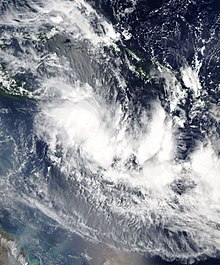
As a tropical low, Owen caused minimal damage in the Solomon Islands from 29 November to 2 December. Actual damage was limited to beach erosion and falling trees.[23]
Northern Territory
On December 10, as a post-tropical low, Cyclone Owen made its first destructive landfall in the Northern Territory.[41] Rainfall amounted to about 20 millimetres (0.79 in).[24] Many of Owen's landfalls in Queensland also affected Northern Territory. December 11 saw Port Roper, Port McArthur, and Groote Eylandt getting hit by floods, heavy rainfall, and high winds.[42] On 12 December, Cyclone Owen, as a Category 3 severe tropical cyclone, made landfall just west of the Queensland/Northern Territory border.[43] After 15 December, Cyclone Owen went to Queensland, and warnings in Northern Territory were lifted.[44]
Queensland
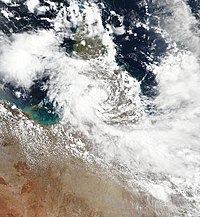
Cyclone Owen made several landfalls in Queensland throughout its duration. Heavy rainfall, flash floods, and storm surge killed one person and caused $25 million worth of damage.[24] On 13 December, extremely heavy winds devastated Cape York in northern Australia.[45] The next day, Owen made another destructive landfall, bringing effects hundreds of miles inland.[33] On 15 December, Owen made another destructive landfall in Queensland.[46] The next day, Owen went out to sea as a subtropical low, and caused some minor damage in the eastern part of Queensland.[24] On 18 December, the extratropical remnants of Owen caused some more minimal damage, before dissipating entirely.[24] When Owen made landfall in the Northern Territory on December 10, there were also minor effects in Queensland.[33]
Throughout its duration, Cyclone Owen dumped very heavy and intense rain on Queensland.[47] On 17 December, when the rapidly dissipating Subtropical Low Owen approached Queensland a fifth time, it caused rain to fall at a rate of over 97 millimetres (3.8 in) per hour. Inland Queensland got about 40 millimetres (1.6 in) per hour.[48] The rainfall caused by Cyclone Owen was the record highest rainfall ever recorded in Australia in the month of December.[49] Catastrophic rainfall occurred as Category 3 Owen made landfall in Queensland.[50]
See also
- Tropical cyclones in 2018
- 2018–19 Australian region cyclone season
- List of Category 3 Australian region severe tropical cyclones: Owen was one of them
- Australian region tropical cyclone
- Cyclone Nora: a similar tropical cyclone that also made landfall in Queensland
References
- "The Australian Tropical Cyclone Database" (CSV). Australian Bureau of Meteorology. A guide on how to read the database is available here.
- "Tropical Cyclone Technical Bulletin: 1 December 2018 18z". United States Joint Typhoon Warning Center. 1 December 2018. Archived from the original on 11 December 2018. Retrieved 30 July 2020.
- "Tropical Cyclone Technical Bulletin: 2 December 2018 00z". United States Joint Typhoon Warning Center. 2 December 2018. Archived from the original on 2 December 2018. Retrieved 3 August 2020.
- "Tropical Cyclone Technical Bulletin: 2 December 2018 12z". United States Joint Typhoon Warning Center. 2 December 2018. Archived from the original on 2 December 2018. Retrieved 3 August 2020.
- "Tropical Cyclone Technical Bulletin: 2 December 2018 12z". United States Joint Typhoon Warning Center. 2 December 2018. Archived from the original on 3 December 2018. Retrieved 4 August 2020.
- "Tropical Cyclone Technical Bulletin: 3 December 2018 00z". United States Joint Typhoon Warning Center. 3 December 2018. Archived from the original on 3 December 2018. Retrieved 4 August 2020.
- "Tropical Cyclone Technical Bulletin: 3 December 2018 06z". United States Joint Typhoon Warning Center. 3 December 2018. Archived from the original on 3 December 2018. Retrieved 5 August 2020.
- "Tropical Cyclone Technical Bulletin: 3 December 2018 12z". United States Joint Typhoon Warning Center. 3 December 2018. Archived from the original on 4 December 2018. Retrieved 6 August 2020.
- "Tropical Cyclone Technical Bulletin: 3 December 2018 18z". United States Joint Typhoon Warning Center. 3 December 2018. Archived from the original on 4 December 2018. Retrieved 6 August 2020.
- "Tropical Cyclone Technical Bulletin: 4 December 2018 00z". United States Joint Typhoon Warning Center. 4 December 2018. Archived from the original on 4 December 2018. Retrieved 10 August 2020.
- "Tropical Cyclone Technical Bulletin: 4 December 2018 06z". United States Joint Typhoon Warning Center. 4 December 2018. Archived from the original on 4 December 2018. Retrieved 10 August 2020.
- "Severe Tropical Cyclone Owen". Bureau of Meteorology. Retrieved 11 August 2020.
- "Tropical Cyclone Technical Bulletin: 11 December 2018 00z". United States Joint Typhoon Warning Center. 11 December 2018. Archived from the original on 11 December 2018. Retrieved 12 August 2020.
- "Tropical Cyclone Technical Bulletin: 11 December 2018 06z". United States Joint Typhoon Warning Center. 11 December 2018. Archived from the original on 11 December 2018. Retrieved 13 August 2020.
- "Tropical Cyclone Technical Bulletin: 11 December 2018 12z". United States Joint Typhoon Warning Center. 11 December 2018. Archived from the original on 11 December 2018. Retrieved 14 August 2020.
- "Tropical Cyclone Technical Bulletin: 11 December 2018 18z". United States Joint Typhoon Warning Center. 11 December 2018. Archived from the original on 12 December 2018. Retrieved 15 August 2020.
- "Tropical Cyclone Technical Bulletin: 12 December 2018 00z". United States Joint Typhoon Warning Center. 12 December 2018. Archived from the original on 12 December 2018. Retrieved 15 August 2020.
- "Tropical Cyclone Technical Bulletin: 12 December 2018 06z". United States Joint Typhoon Warning Center. 12 December 2018. Archived from the original on 12 December 2018. Retrieved 16 August 2020.
- "Tropical Cyclone Technical Bulletin: 12 December 2018 12z". United States Joint Typhoon Warning Center. 12 December 2018. Archived from the original on 12 December 2018. Retrieved 16 August 2020.
- "Tropical Cyclone Technical Bulletin: 12 December 2018 18z". United States Joint Typhoon Warning Center. 12 December 2018. Archived from the original on 13 December 2018. Retrieved 16 August 2020.
- "Tropical Cyclone Outlook: December 2". Web Cite. Joint Typhoon Warning Center. 2 December 2018. Archived from the original on 2 December 2018. Retrieved 15 July 2020.
- "Tropical Cyclone Owen Forms off QLD". higginsstormchasing.com/. Higgins Storm Chasing. 3 December 2020. Retrieved 1 July 2020.
- McCosker, Madeline (2 December 2018). "UPDATE: Tropical Cyclone Owen downgraded". dailymercury.com.au. The Daily Mercury. Retrieved 10 July 2020.
- "Storm Science Australia: Tropical Cyclone Owen". ausstormscience.com. Bureau of Meteorology. Retrieved 4 July 2020.
- Garvey, Cas (9 December 2018). "Zombie cyclone Owen not dead yet as another low forms". qt.com.au. Queensland Times. Retrieved 4 July 2020.
EX-TROPICAL Cyclone Owen is not done yet, with the Bureau of Meteorology tipping it to re-form into a cyclone as they keep a close eye on a second tropical low out in the Coral Sea.
- Jazeera, Al (12 December 2018). "Warnings issued as Tropical Cyclone Owen re-forms near Australia". Aljazeera.com. Retrieved 18 June 2020.
Storm has potential to bring flooding to some of the most populated parts of Queensland.
- Morgan, Adam (12 December 2018). "WEATHER UPDATE: Tropical Cyclone Owen in the Gulf of Carpentaria". media.bom.gov.au. BOM. Retrieved 18 June 2020.
- Garvey, Cas (12 December 2018). "Cyclone Owen now a Category 2". noosanews.com. Retrieved 18 June 2020.
- Wiggins, Nick (13 December 2018). "Cyclone Owen crosses Queensland coast as category three system". abc.net.au. ABC News. Retrieved 19 June 2020.
- "Queensland braces for Cyclone Owen to make landfall". sbs.com.au. SBS News. 13 December 2020. Retrieved 2 July 2020.
Cyclone Owen has strengthened into a category three storm and could be a destructive category four by the time it crosses the Queensland coast on Friday.
- "Queensland warned Tropical Cyclone Owen could become a destructive category four". theguardian.com. Australian Associated Press. 12 December 2018. Retrieved 1 July 2020.
The severe cyclone is expected to cross the Queensland coast on Friday, bringing fierce winds and rain
- Garcia, Joelyn. "Disaster crews 'ready to roll' as Cyclone Owen crosses Queensland coast". brisbanetimes.com.au. Brisbane times. Retrieved 2 July 2020.
- "Queensland Cyclone Owen: Powerful system may wreak havoc". BBC News. BBC. 14 December 2018. Retrieved 19 June 2020.
- Elder, Keegan (13 December 2018). "Cyclone Owen to strengthen to category three system as it moves back toward the Queensland coast". townsvillebulletin.com.au. Townsville Bulletin. Retrieved 4 July 2020.
LATEST: TROPICAL Cyclone Owen is expected to intensify to a Category 3 today.
- "Tropical Cyclone Owen will wreak havoc across Queensland, residents warned". theguardian.com. Australian Associated Press. 13 December 2018. Retrieved 1 July 2020.
Annastacia Palaszczuk says state has done all it can to prepare for severe category-four storm
- Russell, Rachel. "Cyclone Owen path tracker: Tropical Cyclone Owen to 'wreak HAVOC' on Queensland TODAY". express.co.uk. Express. Retrieved 2 July 2020.
CYCLONE Owen is slowly moving over waters near the Northern Territory, in Australia, with winds reaching speeds of up to 124 mph. Here is the latest as Tropical Cyclone Owen is set to wreak havoc on Queensland today.
- Michael, Peter (15 December 2018). "Cyclone Owen downgraded to a tropical low". couriermail.com. Courier Mail. Retrieved 2 July 2020.
Cyclone Owen has rapidly weakened after making landfall on the Gulf of Carpentaria, with senior forecasters now tracking the storm as a tropical low.
- Duffin, Perry; Barnsley, Warren (15 December 2018). "Qld Cyclone Owen downgraded to low system". perthnow.com.au. Perth Now. Retrieved 4 July 2020.
- "Cyclone Owen downgraded, but could re-form off Queensland". bbc.com. BBC News. 15 December 2018. Retrieved 4 July 2020.
- Croft, Hayley (17 December 2018). "Tropical Cyclone OWEN Forecast Discussion". cyclocane.com. Cyclocane. Retrieved 16 June 2020.
- Blašković, Teo (10 December 2018). "Ex-Tropical Cyclone "Owen" forecast to reform in the Gulf of Carpentaria, Australia". watchers.news. The Watchers. Retrieved 8 July 2020.
- "Tropical Cyclone Owen reaches category two, cyclone shelters opened in northeast Top End". ABC News. Australian Broadcasting Corporation. 11 December 2018. Retrieved 15 July 2020.
- "Tropical Cyclone Owen reaches category three on NT coast, may develop to category four today". abc.net.au. Australian Broadcasting Corporation. 12 December 2018. Retrieved 15 July 2020.
- "Ex-Cyclone Owen downgraded to tropical low half a day after crossing Queensland coast". ABC News. Australian Broadcasting Corporation. 15 December 2018. Retrieved 15 July 2020.
- Falvo, Andrea; Ekert, Janessa (13 December 2018). "Alerts sent to Cape York community ahead of Cyclone Owen". cairnspost.com.au. The Cairns Post. Retrieved 7 July 2020.
UPDATE 4.08pm: An Emergency Alert Campaign has been issued for Pormpuraaw ahead of Tropical Cyclone Owen.
- Siganto, Talissa; Major, Tom (15 December 2020). "Ex-Tropical Cyclone Owen dumps more than half a metre of rain in north Queensland". abc.net.au. ABC News. Retrieved 10 July 2020.
- McCosker, Madeline (4 December 2018). "Cyclone to dump heavy rain on Queensland coast". themorningbulletin.com.au. The Morning Bulletin. Retrieved 11 July 2020.
- Gutro, Rob (17 December 2018). "NASA Finds Tiny Remnants of Tropical Cyclone Owen". blogs.nasa.org. NASA. Retrieved 16 June 2020.
- Blašcović, Teo (18 December 2018). "Tropical Cyclone "Owen" sets new Australian December daily rainfall record". watchers.news. The Watchers. Retrieved 11 July 2020.
- Garvey, Cas (11 December 2018). "Owen tipped to reach category 3, hit North QLD". dailymercury.com.au. The Daily Mercury. Retrieved 13 July 2020.